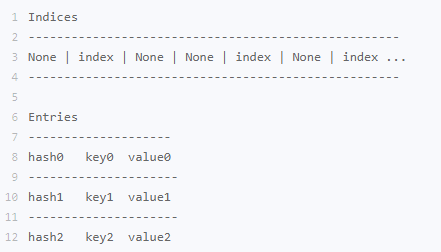@Author :Runsen
字典和集合
字典是一系列无序元素的组合,其长度大小可变,元素可以任意地删减和改变。不过要注意,这里的元素,是一对键(key)和值(value)
相比于列表和元组,字典的性能更优,特别是对于查找、添加和删除,字典都能在常数的时间复杂度内完成
而集合和字典基本相同,唯一的区别,就是集合没有键和值的配对是一系列无序的、唯一的元素组合。
d1 = {'name': 'jason', 'age': 20, 'gender': 'male'}d2 = dict({'name': 'jason', 'age': 20, 'gender': 'male'})d3 = dict([('name', 'jason'), ('age', 20), ('gender', 'male')])d4 = dict(name='jason', age=20, gender='male') d1 == d2 == d3 ==d4True
s1 = {1, 2, 3}s2 = Set([1, 2, 3])s1 == s2True
复制代码
集合并不支持索引操作,因为集合本质上是一个哈希表,和列表不一样
```和集合
s = {1, 2, 3}
s[0]
Traceback (most recent call last):
File "<stdin>", line 1, in <module>
TypeError: 'set' object does not support indexing
想要判断一个元素在不在字典或集合内,我们可以用 value in dict/set
```和集合s = {1, 2, 3}1 in sTrue10 in sFalse
d = {'name': 'Runsen', 'age': 20}'name' in dTrue'location' in dFalse
复制代码
字典的增删改
```和集合
In [1]: d = {'name': 'Runsen', 'age': 20}^M
...:
In [2]: d['gender'] = 'male'
In [3]: d['birthday'] = '1999-10-01'
In [4]: d
Out[4]: {'name': 'Runsen', 'age': 20, 'gender': 'male', 'birthday': '1999-10-01'}
In [5]: d['birthday'] = '1999/10/01'
In [6]: d.pop('birthday')
Out[6]: '1999/10/01'
In [8]: d
Out[8]: {'name': 'Runsen', 'age': 20, 'gender': 'male'}
In [9]: s = {1, 2, 3}^M
...:
In [10]: s.add(4)
In [11]: s
Out[11]: {1, 2, 3, 4}
In [12]: s.remove(4)
In [13]: s
Out[13]: {1, 2, 3}****
**字典的升序和降序排序**```和集合d = {'b': 1, 'a': 2, 'c': 10}d_sorted_by_key = sorted(d.items(), key=lambda x: x[0]) # 根据字典键的升序排序d_sorted_by_value = sorted(d.items(), key=lambda x: x[1]) # 根据字典值的升序排序d_sorted_by_key[('a', 2), ('b', 1), ('c', 10)]d_sorted_by_value[('b', 1), ('a', 2), ('c', 10)]
复制代码
增删查找
字典和集合是进行过性能高度优化的数据结构,特别是对于查找、添加和删除操作
列表的做法
```和集合
list version
def finduniquepriceusinglist(products):
uniquepricelist = []
for _, price in products: # A
if price not in uniquepricelist: #B
uniquepricelist.append(price)
return len(uniquepricelist)
products id 和 price
products = [
(143121312, 100),
(432314553, 30),
(32421912367, 150),
(937153201, 30)
]
print('number of unique price is: {}'.format(finduniquepriceusinglist(products)))
输出
number of unique price is: 3
**集合的做法**
```python
# set versiondef find_unique_price_using_set(products): unique_price_set = set() for _, price in products: unique_price_set.add(price) return len(unique_price_set)
products = [ (143121312, 100), (432314553, 30), (32421912367, 150), (937153201, 30)]print('number of unique price is: {}'.format(find_unique_price_using_set(products)))
# 输出number of unique price is: 3
复制代码
比较运行的时间,也就是性能
import timeid = [x for x in range(0, 100000)]price = [x for x in range(200000, 300000)]products = list(zip(id, price))
# 计算列表版本的时间start_using_list = time.perf_counter()find_unique_price_using_list(products)end_using_list = time.perf_counter()print("time elapse using list: {}".format(end_using_list - start_using_list))## 输出time elapse using list: 41.61519479751587
# 计算集合版本的时间start_using_set = time.perf_counter()find_unique_price_using_set(products)end_using_set = time.perf_counter()print("time elapse using set: {}".format(end_using_set - start_using_set))# 输出time elapse using set: 0.008238077163696289
复制代码
在性能上集合完爆列表
对于字典,哈希表存储了哈希值,键和值这桑三个元素
字典和集合都是无序的数据结构,其内部的哈希表存储结构,保证了查找,插入,删除操作的高效性。所以,字典和集合通常运用在对元素的查找,去重
初始化字典的方式有两种方法,比较下哪一种更高效,
In [20]: timeit a ={'name':"runsen",'age':20}127 ns ± 0.8 ns per loop (mean ± std. dev. of 7 runs, 10000000 loops each)
In [21]: timeit b =dict({'name':"runsen",'age':20})438 ns ± 3.41 ns per loop (mean ± std. dev. of 7 runs, 1000000 loops each)
复制代码
第一种,因为不用调用相关的函数
字典的键可以是一个列表吗?下面这段代码中,字典的初始化是否正确
In [22]: d = {'name': 'Runsen', ['education']: [' primary school', 'junior middle school']}^M ...:---------------------------------------------------------------------------TypeError Traceback (most recent call last)<ipython-input-22-13cd196aef11> in <module>----> 1 d = {'name': 'Runsen', ['education']: [' primary school', 'junior middle school']}
TypeError: unhashable type: 'list'
In [23]: d = {'name': 'Runsen', ('education'): [' primary school', 'junior middle school']}^M ...: ...:
In [24]: dOut[24]: {'name': 'Runsen', 'education': [' primary school', 'junior middle school']}
复制代码
用列表作为 Key 在这里是不被允许的,因为列表是一个动态变化的数据结构,字典当中的 key 要求是不可变的,原因也很好理解.
key 首先是不重复的,如果 Key 是可以变化的话,那么随着 Key 的变化,这里就有可能就会有重复的 Key,那么这就和字典的定义相违背;如果把这里的列表换成之前我们讲过的元组是可以的,因为元组不可变。
参考:https://time.geekbang.org/column/article/94972
本文已收录 GitHub,传送门~ ,里面更有大厂面试完整考点,欢迎 Star。
<br>
<br>















评论